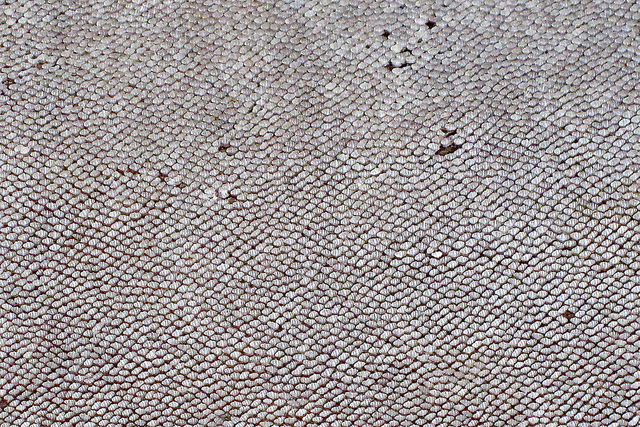Swim Like a Shark
 As Shark Week sinks its teeth into your TV and social media channels, from megalodon – the 50-foot-long “mega-toothed” shark that while extinct chomps on in our imaginations – to Zombie Sharks, you might not realize that we stand to learn a heck of a lot from sharks.
As Shark Week sinks its teeth into your TV and social media channels, from megalodon – the 50-foot-long “mega-toothed” shark that while extinct chomps on in our imaginations – to Zombie Sharks, you might not realize that we stand to learn a heck of a lot from sharks.
A 6th sense—and a 7th: sharks navigate using electromagnetic fields & pressure changes http://t.co/EVYHSmVfHw #SharkWeek
— pew environment (@pewenvironment) August 13, 2014
Among the many things we can learn from sharks – follow @WhySharksMatter for other examples – we can learn to create new materials with self-cleaning, superhydrophobic (“water-hating”) and stunningly low-drag properties. These materials might not help you swim with the sharks (you’d need tiny chain-mail for that) but perhaps swim more like a shark.
“Engineering marvels found throughout living nature continually provide inspiration to researchers solving technical challenges.” – Bixler, Bhushan
For some time now, engineers have been inspired by nano- (1 billionth of a meter) and micro- (1 millionth of a meter) structures that exist in nature. The results of this inspiration have included synthetic biomimetic (“biology imitating”) structures that are super adhesive by harnessing the tiny structures on gecko feet, or better able to absorb sunlight on solar panels by taking inspiration from insect eyes. Velcro? Yep, nature made it first. You’ve probably witnessed it firsthand if you’ve ever tried to remove burs from your dog’s fur.
“Two engineering challenges solved in living nature but plaguing a variety of industries are fluid drag and fouling.” – Bixler, Bhushan
Well, it turns out that engineers have been inspired by shark skin to produce materials that experience low drag when moving through water or air, and materials that are able to remain clean or even clean themselves over time.
Have you ever wondered why airplanes and racecars are shaped like they are? One of the factors is pressure drag. Engineers can reduce pressure drag by creating streamlined geometry in moving objects such as vehicles. Another form of drag is viscous drag, or skin friction drag. This form of drag depends on the surface morphology, or tiny structures on a surface of a material that can promote or reduce friction. Reducing this kind of drag can actually create surfaces that are resistant to “fouling” by dirt, sludge (a problem in pipes), or even bacteria. What if your car never accumulated dirt, oil or ice? Wouldn’t that be nice?
“In living nature, certain flora and fauna benefit significantly from low drag and antifouling. In particular, the skin of fast swimming sharks is especially intriguing due to its low drag and antifouling properties.” – Bixler, Bhushan
Sharks, such as the Mako shark, have skin adorned with tiny ridges or micro-riblets. The ridges are oriented parallel, or in the same direction, as the water flow around the forward-moving shark. The micro-riblets help move water flow around the shark in such a way that turbulent flow, and thus drag, is reduced. With the help of the micro-riblets, turbulent water flow vortexes are lifted off the surface of the shark, which in turn reduces surface fiction and drag.
If you were to shrink yourself down really small, these ridges would look something like multiple half-pipes that you could skateboard from the shark's belly to his dorsal fin.
These tiny riblet morphologies have been replicated on U.S. Olympic racing boats and on the Speedo FastSkin swimsuit worn by Michael Phelps in the 2008 Beijing Olympics. However, perfectly replicating the tiny structures and drag-reducing effects of shark skin in swimsuits has proven difficult. Oriented in the wrong direction on a swimsuit, these micro-ridges could actually slow a swimmer down.
“The skin of fast swimming sharks (such as Mako, Isurus oxyrinchus) is covered with scales called dermal denticles, which contain specially sized and spaced riblets oriented parallel to the swimming direction.” – Bixler, Bhushan
If you look at shark skin under a powerful microscope, you’ll see tiny three-prong-shaped scale-like denticles, which researchers have shown to be the key to increased swimming speed. It appears that these tiny structures not only reduce drag by reducing the wetted surface of the shark, but they actually modify the way water moves around the shark in such a way as to suck, or thrust, the shark forward.
In reducing skin friction drag, the riblets on shark skin and shark-skin-mimetic materials also reduce fouling of surfaces. Particles that are larger than the space between the shark skin ridges, including ocean microorganisms, are unable to attach to the surface in the small valleys between the ridges. Thus the shark remains clean, relatively free of organisms that might attach and grow on a whale’s skin, for example.
Who knew #SharkSkin could be so cool.

